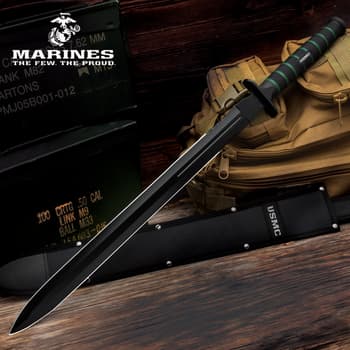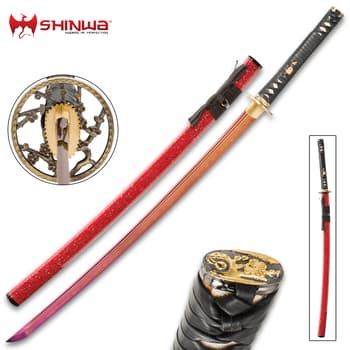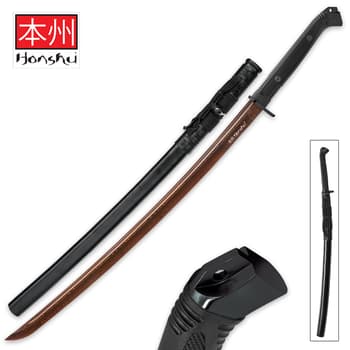Five Types Of Swords

By Adelia Ladson
Swords have slashed and thrust their way through centuries, shaping history through battles and single combat. Developing from the dagger during the Bronze Age, they have continued to change and evolve into masterpieces that have represented individual civilizations across the world. Swords are as individual as the people who carry them. Here are some historical sword types and a little bit about them.
Gladius
The Roman Sword or Gladius originated in Ancient Rome and was carried by legionaries into battle. The sword blade was double-edged for cutting and tapered to a point for thrusting moves. Measuring from 24” to 22” in overall length, the gladius had an ornate knobbed hilt to give it a firm grip and sometimes it was finger-grooved. It was carried in a scabbard that was mounted on a belt or shoulder strap and a centurion wore his on the opposite of his body than the foot soldiers wore theirs. The word “gladiator” (meaning swordsman) actually derived from the word “gladius.”
Roman Guard Gladius Sword
An incredible replica, the Roman Guard Gladius Sword is an ideal historical sword for collectors, reenactors and history buffs alike. Just like the gladius carried and displayed by wealthy Roman guards, it has a stainless steel blade with cast ornate designs and the authentically designed handle offers a cast metal guard and pommel and faux wood grip. Included with the sword is a faux wooden scabbard with a hanging chain.
Two-Handed Great Sword
The two-handed great sword is a Renaissance weapon that was most effective as an infantry sword. It was a beast at between 60” and 70” in overall length with a cruciform hilt. The use of this sword in battle was actually pioneered by the Swiss and Germans not the Italians. It was used mainly for fighting opponents with halberds by cutting off the tops and then also clearing through pikes. Soldiers would use them for slashing and stabbing their way through the battlefield. Larger two-handed swords weighing up to 10 or 15 lbs were known as “parade-swords” and were only used in ceremonial processions.
Legends In Steel Medieval Great Sword
The Legends In Steel Medieval Great Sword is a high-quality reproduction weapon that looks impressive wherever you hang it or display it. It has a high carbon steel blade with a fuller that extends from a curved brass handguard with etched decoration. The handle is steel with a genuine black leather grip and a brass medallion-style pommel with raised decoration. The great sword slides smoothly into its genuine, black leather scabbard, which has a belt loop for carry at your side.
Japanese Katana
The katana is a Japanese sword used by Samurai in feudal Japan. It has a curved, single-edged blade that is slender and a square or circular handguard (tsuba). The handle is long and traditionally wrapped in rayskin and then a “braid” of silk or cotton. The blade is usually about 27 1/2” in length and is sheathed in a scabbard, which is traditionally made of lacquered wood. This weapon was used for slashing and stabbing motions in combat, not necessarily for blocking or clashing. The art of using a katana is still practiced today in martial arts schools.
Shinwa Imperial Dragon Katana
From beauty to power to hand-craftsmanship, the Shinwa Imperial Dragon Katana has everything the serious swordsman and or collector looks for in a top-shelf katana. The full-tang, Damascus steel blade was expertly hand-forged by seasoned swordsmiths using advanced technique honed over centuries. The handle is wrapped in white, genuine rayskin, offset with black, braided cord and detailed brass menuki. The black cast metal tsuba has a circular openwork design that sits above a brass habaki. The katana’s red lacquered wooden scabbard has a spectacularly detailed mother-of-pearl inlay depicting a dragon. The hand-painted sun and cloud accents that encircle the central dragon gives the feel of a traditional Japanese watercolor illustration.
Rapier
The rapier was used mostly in Europe during the 16th and 17th Centuries but did originate in Spain as a “dress sword.” It has a slender, sharply pointed blade, typically sharp on both sides, that was used for thrusting attacks during combat. The hilt is usually a complex affair with the purpose of protecting the hand and it evolved into cup-like shapes over the years. The rapier was considered a “fashionable” weapon for the wealthier class and was used for dueling and self-defense. It is thought that fencing schools have inherited their forms from rapier swordsmanship. This slender sword is still carried, today, by the officers of the Swiss Guard at the Vatican.
Dueling Rapier Sword
Inspired by the days when disputes were settled honorably and swiftly with a sword duel at dawn, the Dueling Rapier Sword is a perfect historical reproduction. The intricate and striking basket-style guard, which is customary for the time-period, is crafted of polished metal alloy. The stainless steel blade has the traditional slim profile, and the handle is made of a sturdy metal with a black ABS grip. A black wooden scabbard with metal accents houses the blade of this magnificent rapier sword.
Saber
The saber was introduced into Western Europe during the 17th Century through the Polish szabla, which was used as a cavalry weapon. It has a curved, single-edged blade with a pointed tip and handguard that covers the knuckles, thumb and forefinger. However, it was not unheard of for this sword to be double-edged. Traditionally, a saber is carried in a scabbard that either hangs from a shoulder belt or waist belt. These weapons saw much use during the Napoleonic Wars and saw some use during the Civil War, especially at the Battle of Gettysburg. The sword was abandoned for combat use as the horse cavalry was replaced with armored cavalry during World War I.
USMC Ceremonial Saber Sword
The officially licensed USMC Ceremonial Saber Sword from United Cutlery makes an excellent, heirloom-quality gift to present to the Marine in your life. The sharp stainless steel blade is embossed with USMC-themed artwork, which includes “United States Marines”. The hilt is polished stainless steel with a TPU grip with wire wrap and a handguard with decorative metalwork and a tassel. The matching scabbard is of black faux leather and features stainless steel decorative accents. The USMC Ceremonial Saber Sword looks great displayed in your home or at the office.
Related Products

























